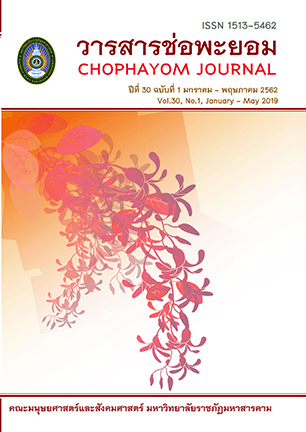Health behavior of the working age population aged 15-59 in Health Regional 5 Area
Keywords:
health behavior, working age, Health Regional 5 AreaAbstract
The objectives of this research were to study the health behavior of the working age population aged 15-59 in Regional Health 5 Area and compare the differences of health behaviors with the studied variables including gender, age, marital status, educational level and profession. The sample group was collected via multi-stage random sampling which included 1,652 workingage population aged 15-59. The questionnaires were used to collect data during April-May 2018. The data analysis was conducted via descriptive statistics, t-test analysis and analysis of variance (ANOVA). The results showed that the majority of female (50.2 per cent), aged 30-44 (34.8 per cent), married (53.1 per cent), finished secondary education (37.4 per cent) and working as service for hire (29.1 per cent). From the sample group, the normal BMI was 18.5-22.9 kg./sq.m. (41.1 per cent), the male’s normal waistline was ≤90 cm. (80.3 per cent) and the female’s normal waistline was ≤80 cm. (53.6 per cent) The sample group had the health behavior in medium level with 6-8 points (49.2 per cent) and the average health behavior was 6.03 points. For health behavior criteria, the sample group’s least passed behavior was no consumption of sweet-flavored
drinks (18.1 per cent) and the most passed behavior was no mere sitting or reclining for more than two consecutive hours (86.7 per cent). When comparing the differences of health behaviors with the studied variables, it showed that different gender, education level and profession caused the differences in health behaviors of the working age population with statistical significance (p<.05). Therefore, academic centers and academic agencies should support all related sectors to impel the right food consumption policies/measures. Also, the public health service units should encourage the appropriate health behavioral proficiency for working age population in order to achieve the goal of healthy populations. Keywords : health behavior, working age, Health Regional 5 Area






